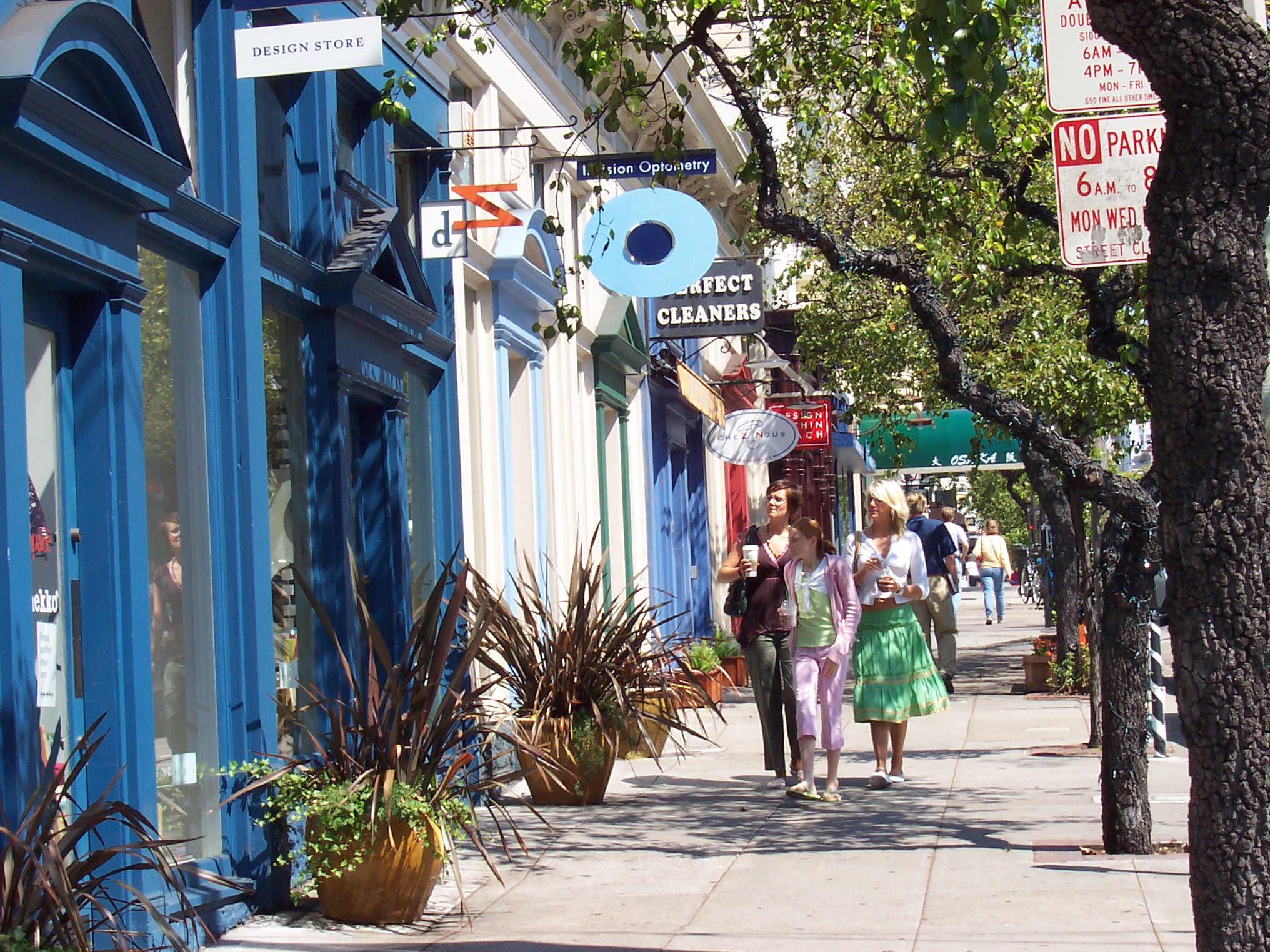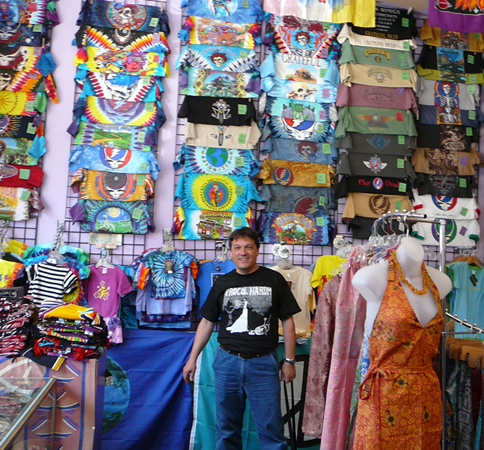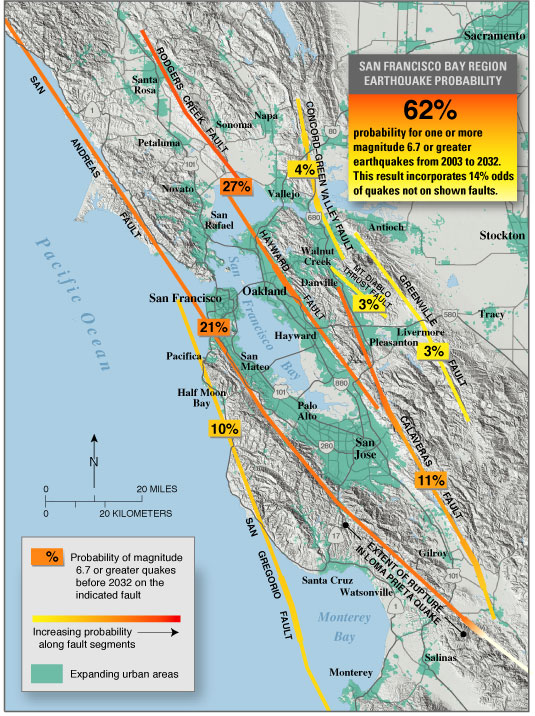San Francisco, located in the region of North California, is known to be the financial and cultural hub of the Bay Area. Interesting enough, San Francisco is the only city in California to make up a whole county. In addition, it consists of the second most dense population in the United States at more than 17 thousand people per square mile, so you can imagine the New York feel of crowdedness in the heart of downtown San Francisco. If you want to avoid the heat, yet in a place where it doesn't get too cold, I would recommend living in San francisco. The weather stays at a cool temperature year round. I was even a bit chilly during the daytime when I visited the city in the middle of August.
source: http://www.demographia.com/db-2000city50kdens.htm
-----------------------------------------------------------------------------------------------------------------
Chapter 2: Environmental Setting
Geography
One of the biggest reasons why visiting San Francisco was so memorable was because the whole city is surrounded by water. Within its boundaries stretch the Pacific Ocean to its west and The San Francisco Bay to its east. What was more fascinating was that the city also consists of several islands such as Alcatraz.Another thing that makes San Francisco so unique is that it is famous for being so hilly. The city consists of more than 50 different hills. In fact, these hills can reach up to 1000 feet in height and so the temperature can actually vary within different parts of the city.
Unfortunately to consider, the city is very prone to having Earthquakes. From Southern California, the San Andreas fault stretch through the area we live in all the way up through the Bay Area. Much like Los Angeles, San Francisco had their fair share of large earthquakes.
Climate
 |
| San Francisco Surrounded by large water bodies |
source:
http://www.sfgate.com/entertainment/article/PEAK-EXPERIENCE-2636879.php
http://www.nps.gov/alca/index.htm
-----------------------------------------------------------------------------------------------------------------
Chapter 3: Historical Settlement
 |
| A paint of the bay area before European Contact |
| San Francisco Mission |
Jumping ahead about 50 years, the Spanish people gained their independence from Spain and became the nation of Mexico. However, California did not stay part of Mexico for much long, when only about 25 years later the United States acquired all of California and other neighboring states through the Treaty of Guadalupe Hidalgo. At this period of time, The San Francisco Bay Area saw its second drastic change, but this one would take it toward what San Francisco is today.
The California Gold Rush helped the small settlement became a city of gold seekers. A flood of Americans from the east would flood the California Coast and the city would forever be white dominant. The city thereon bloom into one of the largest business and ethnic hubs in the country.
Today, San Francisco is a very welcoming city to overseas immigrants. For example, a large group of Chinese immigrants helped form the very well known Chinatown in the city. On the other hand, San Francisco of late has been known to have a very high cost of living causing many middle/lower class citizens t o move out to suburbs within the Bay Area.
source:
http://web.archive.org/web/20060301022510/http://sfgov.org/site/visitor_index.asp?id=8091
http://www.sfmuseum.org/hist1/early.html
http://www.sfmuseum.org/hist1/brick.html
-----------------------------------------------------------------------------------------------------------------
Chapter 4: Political Economy
Yes, you may enjoy the cool weather of San Francisco, but it is not the only reason why I recommend visiting or vacationing in the city. Well it is not a coincidence that the largest tertiary-sector employer in the city would be tourism. San Francisco actually attracts the fourth largest number of foreign tourists in the whole United States. In my own opinion and experience, the reason why tourists are so attracted to the city is because there are an endless amount of sightseeing. Not only does it have the many beautiful sceneries of the bay and skyline, it also has the countless number of landmarks and unique ethnic districts. You can even visit historical sites, like the famous district of Haight-Ashbury.
 |
| Haight-Asbury: known to be the center of the Hippie Movemenet |
Another big business in the tertiary-sector is their banking business. Thanks to the California Gold Rush, San Francisco became a very big banking and financial center in the west coast. In fact, Montgomery Street became known as "the Wall Street of the west". The city is home to many well known banks today such as Wells Fargo and The Pacific Stock Exchange. Even Bank of America was founded in the city.
The final factor to consider in San Francisco's economy is the Dot-Com Bubble. In the 1990s, the internet began to flourish and many businesses related to the field began to pop up in the Bay Area. Many large companies that we know today have started up in San Francisco like Craiglists, Twitter, and Wikpedia.
With all these factors considered, it is no wonder San Francisco is such a notable city in the United States and even the world. It has a very interesting mix between its ethnic and fiancial districts.
source:
http://www.sfgate.com/business/article/S-F-tourism-picks-up-but-spending-stays-flat-3253943.php
http://www.sfgate.com/bayarea/article/New-jobs-houses-spur-S-F-population-in-2007-3284112.php
-----------------------------------------------------------------------------------------------------------------
 |
| Financial District |
With all these factors considered, it is no wonder San Francisco is such a notable city in the United States and even the world. It has a very interesting mix between its ethnic and fiancial districts.
source:
http://www.sfgate.com/business/article/S-F-tourism-picks-up-but-spending-stays-flat-3253943.php
http://www.sfgate.com/bayarea/article/New-jobs-houses-spur-S-F-population-in-2007-3284112.php
-----------------------------------------------------------------------------------------------------------------
Chapter 5: Political Geography
 San Francisco, as already mentioned, is the only consolidated city/county in California. Therefore, the mayor of the city is also the county executive, while the Board of Supervisors acts as the city council. It is also worth mentioning that San Francisco is known to have a majority of democratic supporters like California as a whole In fact, the city is one of the centers for liberal activism and progressive movements. The Bay Area is actually regarded to be one of the most liberal areas in the country.
San Francisco, as already mentioned, is the only consolidated city/county in California. Therefore, the mayor of the city is also the county executive, while the Board of Supervisors acts as the city council. It is also worth mentioning that San Francisco is known to have a majority of democratic supporters like California as a whole In fact, the city is one of the centers for liberal activism and progressive movements. The Bay Area is actually regarded to be one of the most liberal areas in the country.When looking at the population distribution in the Bay Area it is very clear that the population are densest along the bottom half of the bay. The North Bay Area is clearly a lot less populous, where only some suburbs exist.
Demographics
San Francisco is one of those cities that is a minority-majority population meaning non-hispanic whites do not hold majority of the population. This is not necessarily a good or bad thing. It just means that San Francisco is a very ethnically diverse city. The largest minority group in the city are Asians which about a third of the population. Also the city has the largest amount of gay/lesbian individuals within the top 50 most populous cities in the United States. These factors significantly contribute to why the area is so liberal.
| Chinatown |
Source:
http://sf311.org/index.aspx?page=262
http://web.archive.org/web/20070703111703/http://www.sfgov.org/site/bdsupvrs_index.asp?id=4385
http://www.census.gov/population/www/documentation/twps0076/twps0076.html
http://web.archive.org/web/20070702202709/http://www.law.ucla.edu/williamsinstitute/publications/SameSexCouplesandGLBpopACS.pdf
-----------------------------------------------------------------------------------------------------------------
Chapter 7: Natural Hazards
Earthquakes
One of the most obvious natural hazards that the people in the Bay Area face are earthquakes. Some of the issues to consider for having an earthquake in that region are:
Flooding/Mudslides/Landslides
These factor on the other hand are commonly considered throughout many areas of the United States. The San Francisco Bay Area has experienced some flooding due to improper drainage. However, flooding is more frequent in the North Bay Area because its average rainfall is noticeably higher.
Some areas in the Bay Area that are considered to unstable have become urbanized so people living there have to be very precautious to the likelihood of mudslides and landslides. These problems are very common in the Santa Cruz Mountains.
Windstorms/Wildfires
In both late fall and early spring, the San Francisco Bay Area can experience very strong pacific storms. These storms can be hazardous because it can blow down trees and power lines which can cut off necessary power to people. Also strong winds can spread wildfires uncontrollable, especially in the fall when vegetation is the driest.
Source:
http://quake.abag.ca.gov/
http://earthquake.usgs.gov/regional/nca/1868virtualtour/bayarea.php/
http://www.sfmuseum.org/oakfire/berkeley.html
-----------------------------------------------------------------------------------------------------------------
One of the most obvious natural hazards that the people in the Bay Area face are earthquakes. Some of the issues to consider for having an earthquake in that region are:
- The handful of faults that go through the region.
- A very high likelihood of a major earthquake hitting the region within the next 30 years.
- Some areas include very bad soil conditions which can result in more damage.
- Many buildings do not meet the required earthquake code to withstand such a large earthquake.
- Tsunami, a less likely factor but still should be considered because the city is along the coast of the Pacific Ocean.
Flooding/Mudslides/Landslides
These factor on the other hand are commonly considered throughout many areas of the United States. The San Francisco Bay Area has experienced some flooding due to improper drainage. However, flooding is more frequent in the North Bay Area because its average rainfall is noticeably higher.
Some areas in the Bay Area that are considered to unstable have become urbanized so people living there have to be very precautious to the likelihood of mudslides and landslides. These problems are very common in the Santa Cruz Mountains.
Windstorms/Wildfires
In both late fall and early spring, the San Francisco Bay Area can experience very strong pacific storms. These storms can be hazardous because it can blow down trees and power lines which can cut off necessary power to people. Also strong winds can spread wildfires uncontrollable, especially in the fall when vegetation is the driest.
Source:
http://quake.abag.ca.gov/
http://earthquake.usgs.gov/regional/nca/1868virtualtour/bayarea.php/
http://www.sfmuseum.org/oakfire/berkeley.html
-----------------------------------------------------------------------------------------------------------------
Chapter 8: Transportation
Transportation is probably one of my favorite topics regarding the city of San Francisco. Living in Los Angeles almost all my life, I was caught by surprise with the extent of how dedicated transportation is in the city San Francisco. In Los Angeles, you cannot reach most of your destinations without a car, and from experience getting from point A to point B using the LA metro system tends to be inefficient. However when visiting San Francisco I was able to get to any point of city that I wanted using a 3-day bus pass. Not only were there a source of transportation to every location I wanted to reach, there were many times more than one form of transportation to get there.
The Forms of Public Transportation
It is an interesting fact that about 32% of San Francisco residents use public transportation to and from work, which ranks it 3rd in the United States and first in California. Like the Los Angeles Metro, San Francisco transportation program is called Muni or San Francisco Municipal Railway. The Muni which is the 7th largest transit system in the United States consists of light rail, subway, a bus network, and streetcar line. Cable cars are also another form of transportation but it would make sense for residents to ride them. It is known more to be a tourist attraction. When I visited San Francisco it actually took about an hour to get one of the cable cars so I cannot imagine why someone would use as a form of real transportation. What I also have found to be fascinating is the Transbay Tube. This line runs underwater across the San Francisco Bay.
Not only is travel extremely accessible through public transportation around the city, it has lines that go to other major parts of the Bay Area. Similarly, Chicago part of the Great Lakes/Corn Belt region, also has an extensive transportation system
Source:
http://www.sfmta.com/cms/rsrtp/documents/09Chapter4-CurrentServiceaccessible-fy08PublicDraftforMTAB10-2.pdf
http://www.sfgate.com/traveler/guide/transportation/publictrans.shtml
-----------------------------------------------------------------------------------------------------------------
The Forms of Public Transportation
It is an interesting fact that about 32% of San Francisco residents use public transportation to and from work, which ranks it 3rd in the United States and first in California. Like the Los Angeles Metro, San Francisco transportation program is called Muni or San Francisco Municipal Railway. The Muni which is the 7th largest transit system in the United States consists of light rail, subway, a bus network, and streetcar line. Cable cars are also another form of transportation but it would make sense for residents to ride them. It is known more to be a tourist attraction. When I visited San Francisco it actually took about an hour to get one of the cable cars so I cannot imagine why someone would use as a form of real transportation. What I also have found to be fascinating is the Transbay Tube. This line runs underwater across the San Francisco Bay.
Not only is travel extremely accessible through public transportation around the city, it has lines that go to other major parts of the Bay Area. Similarly, Chicago part of the Great Lakes/Corn Belt region, also has an extensive transportation system
 |
| Transbay Tube |
http://www.sfmta.com/cms/rsrtp/documents/09Chapter4-CurrentServiceaccessible-fy08PublicDraftforMTAB10-2.pdf
http://www.sfgate.com/traveler/guide/transportation/publictrans.shtml
-----------------------------------------------------------------------------------------------------------------
Chapter 9: The City and its Culture
 San Francisco is very well known for its culture status. When you walk around the city, it will be apparent that the city has a culturally fascinating streetscape. Whenever I see images of the city streets, it is very easy to identify that the photos are taken in San Francisco. The architecture of the buildings and design of the streets make the city easily distinguishable.
San Francisco is very well known for its culture status. When you walk around the city, it will be apparent that the city has a culturally fascinating streetscape. Whenever I see images of the city streets, it is very easy to identify that the photos are taken in San Francisco. The architecture of the buildings and design of the streets make the city easily distinguishable.Another thing that extremely affected the look and feel of the city is the result of the dot-com boom. With the significant demand of new workers in the technological field, there has a been a clear shift from blue-collar workers to white-collar works. As a result many of the neighborhoods in San Francisco which were common to the middle/lower class residents have witnessed gentrification. That is, these neighborhoods experienced mass redevelopment into higher class businesses, restaurants, and residential buildings.
As already mentioned before San Francisco has a large immigrant population. Therefore, the city has a considerable influence by these newcomers. Many neighborhoods are dedicated to different ethnic groups, and the look of the neighborhoods themselves evidently reflect it such as Chinatown.
 |
| A typical store in the Haight/Ashbury district |
San Francisco, being the hub of liberal activism, also has great influence on the look and feel of the city. Especially when visiting the district of Haight and Ashbury, you get a good sense of the hippie feel when you walk the streets. There were countless number of smoke shops, bars, music stores in which you would attract the young adults.
Source:
http://web.archive.org/web/20050211032911/http://spur.org/documents/010701_article_03.shtm
http://www.mercer.com/referencecontent.htm?idContent=1307990
http://web.archive.org/web/20070710072642/http://www.sfgov.org/site/uploadedfiles/moed/economic_strat/ExecutiveSummary_EconomicPerformanceReview.pdf
-----------------------------------------------------------------------------------------------------------------
Chapter 10: San Francisco Media and Entertainment
San Francisco is recognizable in the United States for many other reasons. The cities performing arts center hosts one of the popular performing-art companies in the country. It is also very notable that San Francisco hosts the second largest opera company in North America.
Musuems
Musuems
- San Francisco Museum of Modern Art- It exhibits 20th Century and Contemporary Art and gets about 600,000 visits a year.
- California Academy of Science- A natural history museum.
- De Young Musuem - Fine arts musuem.
 |
| San Francisco Museum of Modern Art |
Media
- San Francisco Chronicle-It is equivalent to the Los Angeles Times we have here. It is the most widely read paper in northern Calfornia.
- San Francisco has the 6th largest television market and 4th largest radio market in the United States
 |
Sports/Recreation
- 49ers- San Francisco's longest hosted professional sports franchise.
- Giants-San Francisco's hosted professional baseball team.
- San Francisco Marathon - More than 21,000 participants.
 |
| Candlestick Park |
Source:
http://www.sfgate.com/sports/article/S-F-Marathon-26-2-miles-of-feel-good-pain-3223749.php
-----------------------------------------------------------------------------------------------------------------
-----------------------------------------------------------------------------------------------------------------
Subscribe to:
Posts (Atom)



